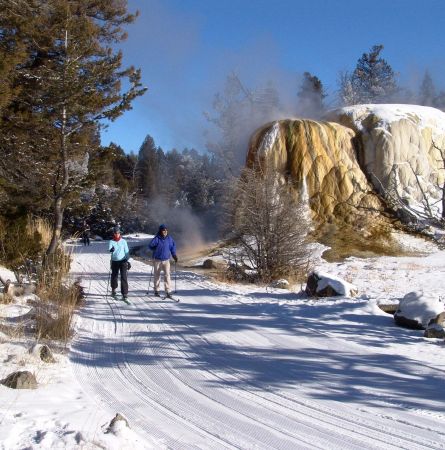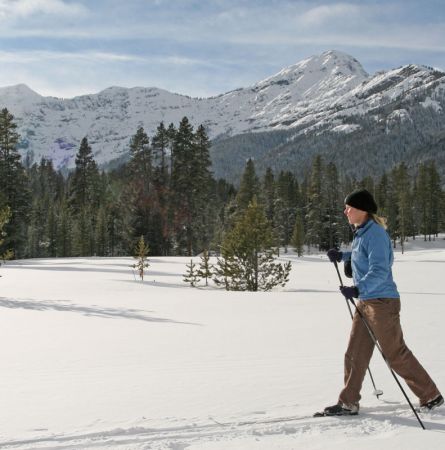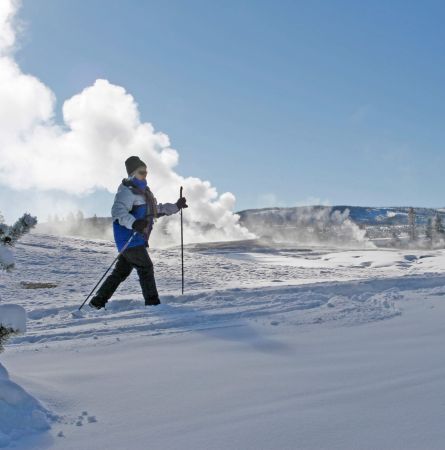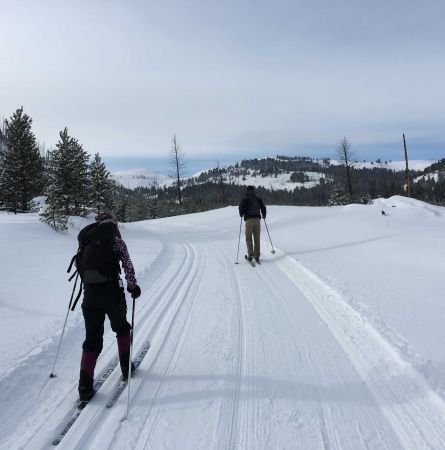Interagency Access Pass
Ski Trails in Yellowstone
Ski and Snowshoe Trails in Yellowstone National Park
Yellowstone offers a variety of enjoyable and challenging trails for cross-country skiers of all experience levels. All trails are marked but may be untracked. The quality of your experience will depend upon the amount of planning and preparation you do prior to your trip. We suggest that you stop at a visitor center or ski shop and discuss your trip. The staff will be happy to provide current information on weather, trail, and snow conditions and alert you to any special winter hazards.
Call the Bear Den Ski Shop at 307-344-5699 for up-to-date trail conditions.
Here are some helpful tips to make the most of your winter cross-country skiing adventure in Yellowstone.
Trail Ratings
Trails are rated by the National Park Service and are specific to Yellowstone National Park. We strongly encourage all skiers to inquire at a Visitor Center or the Bear Den Ski Shops before beginning your first ski trip. Weather conditions may cause icy trails, deep snow, or barren sections, and in some instances make trails difficult to follow, increasing the difficulty of a trail. Trails are not groomed or checked daily.
Easiest – Skiers need basic knowledge and limited experience in the diagonal stride, snow plowing, and side-stepping techniques. Trails may have short downhill and uphill stretches.
More Difficult – Skiers must be able to ski in varied terrain, which requires turning, snow plowing, herringboning, and diagonal strides.
Most Difficult – Skiers must be experienced. Trails are hazardous, and the terrain is frequently extreme. Turns are often sharp and linked together with no room to snow plow or herringbone.
Trail Etiquette
• Do not snowshoe or walk directly on ski tracks.
• Skiers/snowshoers going uphill yield to those going downhill.
• Fill in depressions in the snow after falling to reduce hazards to others.
• Ski within your ability. If you find the trail too difficult, turn back
Wildlife
Do not approach wildlife. Park regulations require you to remain at least 75 feet (23 m) from bison and other large animals and 300 feet (91 m) from bears and wolves. Never approach animals. Give them time to move away from you or travel around a herd, not through it. Always allow animals an escape route through shallow snow or on a packed trail.
General Safety Practices
Pets – Are not allowed on ski trails or in backcountry areas.
Backcountry Trials – Do not attempt to travel any backcountry trails without a good topographical map and inquiring about trail conditions. Many backcountry trails are difficult to find and follow and are not well-marked for winter travel. Many go through avalanche-prone areas. Watch closely for orange trail tags marking the route, they may be challenging to find.
Hazards – Trails may have natural hazards such as animals, avalanches, thermal features, downed trees, steep slopes, and cliffs. When skiing near thermal areas, stay on marked trails. Approaching thermal features is dangerous and prohibited. The snow in these areas is often icy, and what appears to be bare ground may be a thin crust over boiling water.
Weather – Winter weather in Yellowstone changes rapidly and can be severely cold and windy. Wear proper clothing layers. Watch yourself and other members of your party for signs of frostbite and hypothermia.
Have a plan – For your safety, always ski with someone else. Tell someone where you are going, by what route, and when you plan to return. Carry extra clothing, food, water, maps, compass, matches, flashlight, and a whistle.
Elevation – Consider elevation when deciding on a ski trail. Many ski trails are at high elevations, above 6000 feet (1,829 m), and may require you to move slowly when you are out of breath. Always drink plenty of water.
Avalanches – Can occur on any slope, and hazards will not always be marked. In avalanche-prone areas, carry a shovel, avalanche transceiver, probe, and first aid kit—and know how to use them. Cross slopes one at a time, while others watch from safety.



